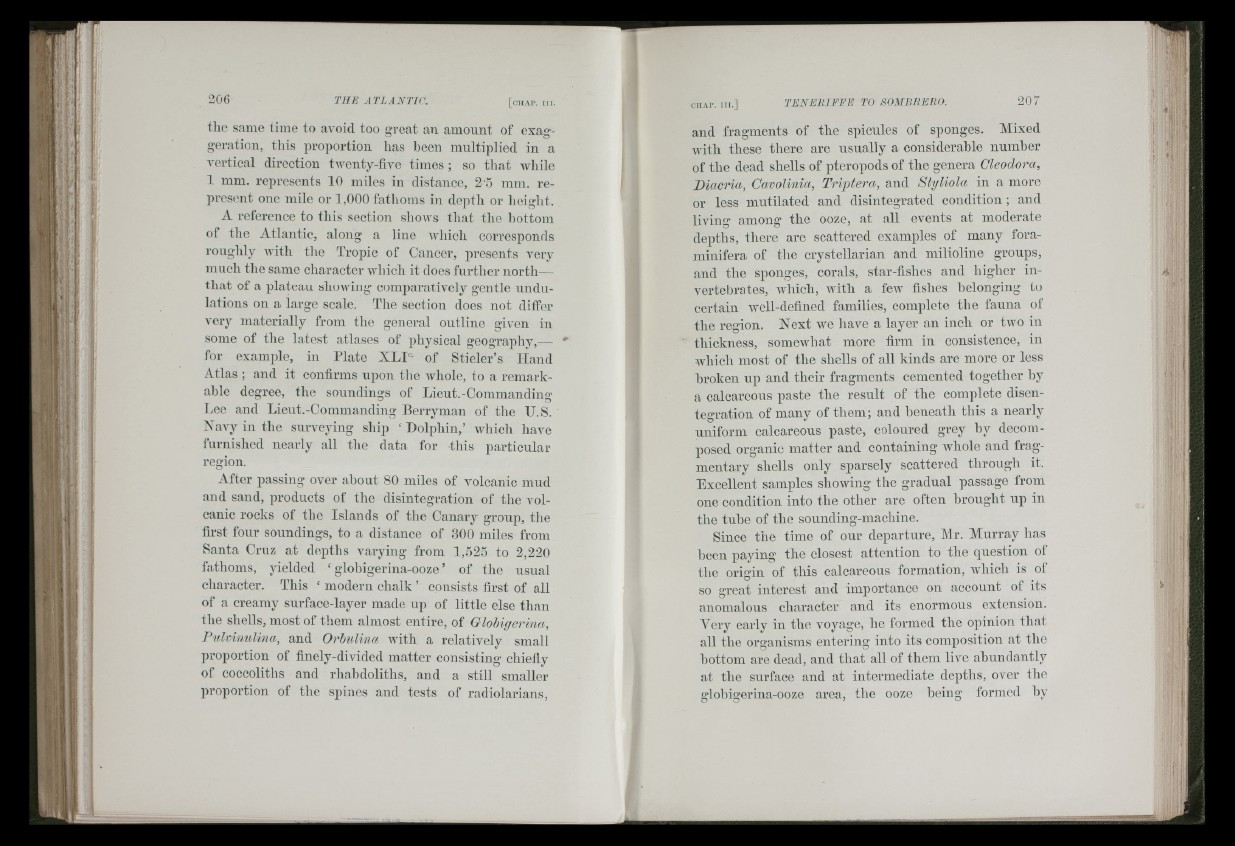
: it
■I
■'-t'
^1-
■
1t ei k:f
te '
I«}!';'=-.i ■i i 1 .A ! 5i
!4
the same time to aA'oid too great an amount of exaggeration,
this proportion has been multiplied in a
A-ertical direction twenty-five times ; so that while
1 mm. represents 10 miles in distance, 2'5 mm. represent
one mile or 1,000 fathoms iu depth or iieight.
A reference to this section shoAvs tliat the hottom
of the Atlantic, along a line Avliich corresponds
roughly Avith the Tropic of Cancer, presents very
much the same character Avhich it does further north—
that of a plateau shoAviiig comparatively gentle undulations
ou a large scale. The section does not differ
very materially from the general outline given in
some of tlie latest atlases of physical geography,—
for example, iu Plate XLI®- of Stieler’s Hand
Atlas ; and it confirms upon the whole, to a remarkable
degree, the soundings of Lieut.-Commanding
Lee and Lieut.-Commanding Berryman of the U.S.
Navy in the surveying ship ‘ Dolphin,’ which have
furnished nearly all the data for this particular
region.
After passing over ahout 80 miles of volcanic mud
and sand, products of the disintegration of the volcanic
rocks of the Islands of the Canary group, the
first four soundings, to a distance of 300 miles from
Santa Cruz at depths A'arying from 1,525 to 2,220
fathoms, yielded ‘ globigerina-ooze ’ of the usual
character. This ‘ modem chalk ’ consists first of all
of a creamy surface-layer made up of little else than
the shells, most of them almost entire, of Glohigerina,
Pulvinulina, aud Orhulina Avith a relatively small
proportion of finely-divided matter consisting chiefly
of coccoliths aud rhahdoliths, and a still smaller
proportion of the spines and tests of radiolariaus.
'B
41
and fragments of the spicules of sponges. Mixed
Avith these there are usually a considerable number
of the dead shells of pteropods of the genera Cleodora,
Biacria, CavoUnia, Triptera, and StyUola in a more
or less mutilated and disintegrated condition ; and
livino’ amou2[ the ooze, at all events at moderate
depths, there are scattered examples of many foraminifera
of the crystellarian aud milioline groups,
and the sponges, corals, star-fishes and higher in-
vertehrates, which, Avith a fcAV fishes helonging to
certain Avell-defined families, complete the fauna of
the region. Next we have a layer an inch or two in
thickness, somewhat more firm in consistence, in
AAdiich most of the shells of all kinds are more or less
broken up and their fragments cemented together hy
a calcareous paste the result of the complete disen-
tegratiou of many of them; aud beneath this a nearly
uniform calcareous paste, coloured grey hy decomposed
organic matter aud containing whole and fragmentary
shells only sparsely scattered through it.
Excellent samples showing the gradual passage from
one condition into the other are often brought up in
the tube of the soundiug-machine.
Since the time of our departure, Mr. Murray has
heen paying the closest attention to the question ot
the origin of this calcareous formation, Avhich is of
so great interest and importance ou account of its
anomalous character and its enormous extension.
Very early in the voyage, he formed the opinion that
all the organisms entering into its composition at the
hottom are dead, and that all of them live abundantly
at the surface aud at intermediate depths, over the
globigerina-ooze area, the ooze heing formed hy
W
'I NimU\ '' ^
.I ^■ vm. ■' . [I >3(1.::;,
' !l i»'“'
A